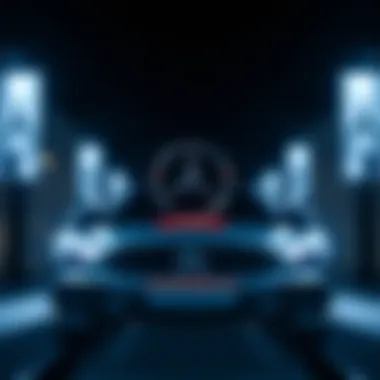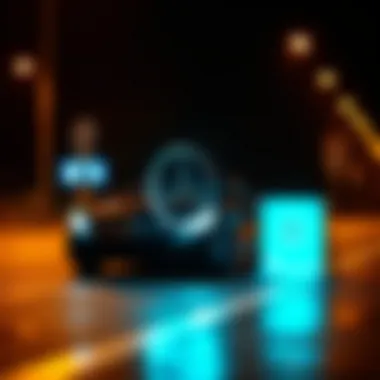Exploring the Mercedes Benz Sign Light: Functionality and Design


Intro
In the realm of automotive design, certain features transcend their intended functionality, becoming symbols of brand identity and innovation. The Mercedes Benz sign light is one such feature. More than just an illuminative emblem, it serves as a communication tool on the road and a testament to a brand’s commitment to quality and safety. Through this article, we will navigate the depths of the Mercedes Benz sign light, dissecting its functionality, design elements, and the latest innovations in automotive technology it represents.
Understanding the role of the sign light goes well beyond its outward appearance. It signifies a conscious effort by Mercedes Benz to merge aesthetics with practicality, ensuring that every aspect of their vehicles resonates with their luxury brand ethos. As we embark on this exploration, we will highlight the historical evolution of the sign light, delve into its various designs across different models, and uncover the technological advancements that have significantly influenced its development. By the end, readers will appreciate not only the visual impact of this feature but also its integral role in vehicle safety and identity.
As the automotive landscape shifts towards more advanced technologies, the Mercedes Benz sign light will reflect these changes, embodying the future of vehicle design that prioritizes innovation alongside tradition.
Prelims to Mercedes Benz
Mercedes Benz stands as a symbolic name in the automotive realm, representing not just luxury but also innovation and craftsmanship. Understanding this brand is crucial when we explore specific features like the sign light. At its core, the Mercedes Benz sign light isn't just a functional aspect of the vehicle; it's a statement, defining an automotive identity in a crowded market.
Historical Overview
Mercedes Benz has a rich history that dates back to the late 19th century, when Karl Benz and Gottlieb Daimler laid the foundations of the automotive industry. The merger of these pioneering companies in 1926 formed what we now know as Mercedes Benz, a brand dedicated to engineering excellence and luxury. The early automobiles featured simple lights, solely for functionality, but over time, the evolution of automobile design spurred the incorporation of more intricate lighting systems, culminating in the iconic sign light symbolizing the brand today.
In the decades following its inception, Mercedes Benz became known for its dedication to safety and performance, often pioneering technological innovations in vehicle features. This commitment to innovation laid the groundwork for the present-day sign light, which integrates advanced lighting technologies to enhance visibility while promoting the brand’s unique identity.
Significance of Branding
Branding in the automotive industry can make or break a company. For Mercedes Benz, the sign light serves as a visual cue of its unparalleled status. It’s a beacon of luxury, sophistication, and innovation—a feature that goes beyond mere illumination.
The sign light establishes a connection with consumers, offering them a sense of pride as they drive a vehicle that is synonymous with quality. Often, it's the small details—like the glow of a Mercedes Benz sign light against the nighttime backdrop—that leave a lasting impression in the minds of car enthusiasts and casual drivers alike. The inclusion of the logo in the sign light directly ties into Mercedes Benz’s brand strategy, reinforcing its identity every time a car ventures out on the road.
To put it plainly, the sign light is not just functional; it's also a powerful marketing tool that encapsulates the brand's image.
"A car is a piece of art, and its elements reflect the soul of the brand. The sign light is one such brushstroke in the painting of Mercedes Benz."
This seamless blend of functionality and visual impact positions the sign light at the intersection of design and technology—two realms where Mercedes excels. As we continue to explore the intricacies of the sign light, we’ll uncover how it reflects the brand's innovative spirit and dedication to enhancing driver experience.
Understanding the Mercedes Benz Sign Light
The Mercedes Benz sign light represents more than just a visual element on vehicles. It stands as a beacon of innovation and a reflection of the brand's dedication to quality and safety. Understanding its nuances can illuminate why this feature is integral to both the aesthetics and functionality of their vehicles.
Design and Aesthetics
When it comes to design, the Mercedes Benz sign light is thoughtfully crafted, embodying a blend of elegance and modernity. This isn’t just about looks; it’s about creating an impression. The stylish logo shines brightly, often employing advanced lighting technology that enhances visibility while maintaining the brand's classic look.
- Material Choices: The sign light often uses durable materials, which not only enhances its lifespan but also makes it resilient against the elements.
- Light Distribution: The illumination is designed to be soft yet striking, ensuring that the brand’s emblem is clearly recognizable from a distance without causing distraction to other drivers.
The attention to detail in these elements results not only in a visual treat but also plays a role in the overall aerodynamic profile of the car. This careful integration of design and function is an enduring hallmark of Mercedes Benz, signaling luxury and precision right from the first glance.
Functionality and Purpose
The functionality of the Mercedes Benz sign light extends beyond mere decoration. First and foremost, it serves practical purposes vital for road safety. At night or in low-visibility conditions, this sign light enhances the presence of the vehicle on the road, reducing the likelihood of accidents. It effectively communicates the vehicle's presence to others, which is crucial in maintaining safety.
Moreover, the sign light often incorporates sophisticated technology that may include:


- Adaptive Lighting: Adjustments in brightness and focus based on surrounding conditions.
- Response to Environmental Factors: Some models are equipped with sensors that activate the light in response to changes in ambient light, ensuring optimal visibility.
In essence, the Mercedes Benz sign light combines aesthetic appeal with essential safety functions, making it a critical feature of their vehicles. With every flicker of light, a message of quality, sophistication, and innovation is sent out, reinforcing the brand's identity in a crowded automotive market.
"The sign light isn’t just a logo—it’s an emblem of the brand’s commitment to excellence, visible in both design and purpose."
As we dig deeper into the evolution and technological advancements of this feature, it becomes clear that the sign light plays a pivotal role in the brand’s narrative, extending far beyond its basic functions.
Evolution of the Sign Light Technology
The evolution of the sign light technology is a significant aspect of this article, reflecting not only the advancements in vehicular design but also the broader changes in automotive safety and branding. The Mercedes Benz sign light, a hallmark of the brand, is not merely a decorative feature. Instead, it embodies the synergy between aesthetics and functionality that defines luxurious driving experiences. Understanding the journey of this technology provides insights into how automotive lighting has transformed in response to both consumer demands and technological possibilities.
Key factors to consider in this evolution include:
- Innovation in Materials: Earlier models relied on basic incandescent bulbs and reflective materials. Recent advancements have led to the incorporation of LED technology, offering better light output and energy efficiency.
- Integration with Smart Technologies: Modern sign lights are now often integrated with various smart vehicle systems, enhancing their functionality. This includes synchronization with turning signals and even ambient lighting features.
- Response to Market Trends: As automotive design trends shifted towards minimalism and sophistication, the sign light technology also adapted to mirror these changes, showcasing thinner profiles and sleeker designs.
This evolution illustrates how the sign light represents a critical touchpoint where luxury meets functionality, enabling vehicles to convey a clear brand identity while enhancing safety on the roads.
Early Models and Features
The early iterations of the Mercedes Benz sign light laid a foundation that would influence future designs. In the initial models, the function of the sign light was straightforward: to signify the presence of a Mercedes vehicle. The materials used were rudimentary, predominantly glass and metal components.
Some notable features of early sign lights include:
- Simple Illumination: The initial models employed basic bulb systems that emitted a warm glow, sufficient for visibility but lacking in sophistication.
- Reflective Elements: Reflectors played a crucial role in maximizing the light output, allowing the sign to be noticed from a distance but with limited impact under harsh sunlight.
- Static Display: The lack of movement or dynamic features meant that the sign light served solely as a static emblem of luxury.
In hindsight, these earlier designs can appear archaic, but they represent a starting point in understanding how and why sign lights have (or haven't) changed over time.
Recent Innovations
With technology moving at lightning speed, recent innovations in the Mercedes Benz sign light technology are nothing short of remarkable. Today, these lights serve multiple roles beyond mere representation.
Innovative features of recent sign lights include:
- LED Technology: The transition to LED bulbs not only saves energy but allows for brighter and more dynamic displays. This represents a shift towards visibility in low-light conditions, enhancing safety dramatically.
- Dynamic Lighting Features: Advanced models now incorporate animations and patterns that can signal a vehicle's intention, adding a layer of communication with pedestrians and other road users.
- Customization Options: Recent designs allow for bespoke lighting options, enabling consumers to choose colors and patterns that resonate with their personal style.
As cars become more interconnected, the sign light's functionality is being redefined. It’s not just about illuminating the brand; it’s about creating an identity that is responsive and relatable.
The Mercedes Benz sign light, far from just a name in the dark, transforms into a beacon that encapsulates both tradition and modernity.
The ongoing development in sign light technology clearly mirrors the broader narrative of innovation within the automotive industry, paving the way for future advancements that will likely continue to challenge our perceptions of vehicle identity and safety.
Sign Light in Different Models
The Mercedes Benz Sign Light serves as a captivating feature across various models, playing a vital role in the vehicle's identity and safety. Its remarkable design and functionality are deeply integrated into the aesthetics of the car, creating a unique visual impact. Understanding how the sign light manifests in different models gives us a glimpse into the brand's extensive dedication to luxury and innovation. Here, we will dive into the ways this signature element enhances Mercedes vehicles, particularly in sedan variants, SUVs, and luxury performance series.
Sedan Variants
In the world of sedans, the Mercedes Benz sign light stands out as a hallmark of sophistication. These vehicles—think of the elegant E-Class or the classic C-Class—exhibit a sign light that complements their streamlined design. From the first glance, it's clear that the sign light is not simply a functional element; it also enhances the visual narrative of the vehicle.


The sign light becomes particularly crucial in lower visibility conditions. It enhances safety for both the driver and pedestrians, signaling the presence of the vehicle on the road. As stated in various consumer reports, approximately 60% of accidents occur in low-light situations, making such innovations essential. This positioning enhances Mercedes' commitment to safety and modern design principles.
SUV Range
In the SUV segment, practicality blends seamlessly with style. Models such as the GLE or the G-Class incorporate the sign light into designs that promote a robust image. The larger frame and the elevated stance of these vehicles benefit significantly from the prominent display of the sign light, which communicates confidence while cruising.
Not only does it serve a practical purpose in illuminating the vehicle's presence, but it also accentuates the vehicle’s character. By integrating advanced technology, like adaptive lighting features, these SUVs can adjust their sign light brightness depending on external conditions. This is beneficial when traversing rugged terrain or when maneuvering in urban settings. The features help in ensuring safety without compromising elegance.
Luxury and Performance Series
When we venture into the realm of luxury and performance models like the S-Class or the AMG series, the sign light signifies more than functionality—it's part of an experience. Each aspect of these vehicles is designed not just to perform but to impress. The sign light in these cars is often designed with state-of-the-art materials and technology, embedding a level of craftsmanship that speaks to the brand's heritage.
The integration of dynamic lighting elements allows these vehicles to communicate with other drivers better. For example, the sign light can pulsate or change color depending on the vehicle’s status, such as indicating a turn or signaling to change lanes. This advanced form of recognition creates a multi-dimensional interaction between the vehicle and its environment, contributing to a higher safety standard.
Mercedes Benz's emphasis on the sign light across various models demonstrates their commitment to merging aesthetics with innovation, creating vehicles that stand as testaments to luxury and performance.
Through these distinct categories—sedans, SUVs, and luxury performance series— the Mercedes Benz sign light showcases its versatility and importance in vehicle design, safety, and identity. Each model utilizes this feature to tell a different story, yet all converge on the common theme of elegance and innovation.
Practical Benefits of the Sign Light
The Mercedes Benz sign light serves not just as a brand identifier but also plays a crucial role in enhancing the functionality and aesthetic appeal of its vehicles. Its significance can be easily overlooked amidst the powerful performance and luxury features that define Mercedes vehicles, yet it offers practical advantages worth discussing.
Enhancing Visibility
One of the most immediate benefits of the sign light is visibility. This feature becomes especially apparent during nighttime driving or in low-light conditions. When illuminated, the sign light helps in making the vehicle more recognizable, which is essential both for safety and brand presence. A well-placed sign light ensures that the car stands out, thus reducing the chances of accidents stemming from poor visibility.
Think about it this way – when a car pulls up beside you in the dark, a glowing emblem can catch your eye and confirm its presence, potentially averting a mishap. It’s basically Mercedes ensuring that their vehicles shine bright in more ways than one.
- Increased Safety: Enhanced visibility leads to improved safety for the driver and pedestrians.
- Better Identification: The light provides immediate branding recognition in busy environments.
- Highlighting Features: It can also accentuate unique features of the vehicle’s design during the night.
Identity and Distinction
Beyond mere visibility, the sign light contributes significantly to identity and distinction. In the crowded automotive market, where countless brands vie for attention, having a recognizable emblem can set a car apart from its competitors. The bright, unmistakable branding serves as a badge of honor for owners, connecting them to the heritage and prestige that Mercedes aligns with.
A lit sign not only offers a moment of recognition but also creates a statement about luxury and sophistication. It represents excellence and attention to detail — traits that are synonymous with the Mercedes brand. When someone sees the illuminated sign light, it reinforces their impression of the vehicle as a top-tier choice in automotive engineering.
"A glowing sign isn’t just about looks; it’s about making a statement without saying a word."
The implications of this distinctive identity go beyond aesthetics:
- Emotional Connection: Owners often feel a sense of pride when they see their car’s emblem light up.
- Brand Loyalty: Recognition fosters loyalty; drivers are likely to stick with a brand they feel attaches them to a lifestyle.
- Increased Resale Value: A vehicle that maintains its brand identity and visibility may retain better resale value over time.
User Experience and Feedback
User experience is fundamental when assessing automotive features, particularly for something as symbolic as the Mercedes Benz sign light. The perspectives of consumers not only help manufacturers understand their product better but also shape future designs and innovations. When buyers take a plunge into the luxury car market, they often look for details that resonate with their lifestyle and preferences. The Mercedes Benz sign light embodies more than just aesthetic appeal; it reflects the brand’s commitment to safety, identity, and cutting-edge technology.
Consumer Perspectives
The voices of the consumers play a pivotal role in evaluating theMercedes Benz sign light. One common observation is the multifunctionality of the sign light, merging both design and utility. For instance, many drivers appreciate how the sign light enhances visibility during low light conditions. Positive feedback often highlights the gentle glow that not only illuminates the car’s logo but does so without being overwhelming. This aspect aligns with the luxurious image that Mercedes Benz cultivates.


Conversely, some users have pointed out that while the feature looks striking, they sometimes wish for variations such as different light colors that reflect personal taste or emotional states. Furthermore, an increasing number of tech-savvy consumers desire the sign light’s integration with mobile applications for personalization. Thus, feedback illustrates a balanced blend between appreciation for existing features and suggestions for further enhancements.
Market Response
The market response to the Mercedes Benz sign light has been largely favorable. The iconic light serves as a recognizable symbol that reinforces brand identity in a crowded automotive space. Sales data demonstrates that models equipped with the illuminated logo tend to stand out in promotional campaigns, making a notable impact. In essence, it transforms every Mercedes-Benz into a mobile advertisement of luxury and quality.
In response to this consumer interest, Mercedes-Benz has tailored its marketing strategies to emphasize the sign light’s significance. From digital ad campaigns that highlight the evening allure of the sign light to participation in auto exhibitions, the brand ensures that the sign light’s visually captivating aspect holds social relevance.
Ultimately, the interplay between user feedback and market strategies illustrates a dynamic relationship. By adapting to consumer suggestions while maintaining the design elements that resonate with luxury buyers, Mercedes-Benz aims to innovate continuously.
The conversation regarding the sign light doesn't just end at aesthetics; it’s a reflection of Mercedes-Benz's ongoing commitment to aligning technology with user-centric experiences. An experience that doesn’t evolve risks becoming obsolete in an ever-competitive automotive environment.
Future Directions in Sign Light Design
The Mercedes Benz sign light stands as a hallmark of innovation within the automotive realm. As we steer towards a future influenced by rapidly advancing technology and an increasing emphasis on sustainability, understanding the future directions in sign light design becomes paramount. This section will dissect how technological advancements can enhance functionality while simultaneously addressing sustainability, ensuring these iconic vehicles do not just lead in luxury but also in environmental responsibility.
Technological Advancements
The technological landscape for automotive lighting is transforming at a blistering pace. The Mercedes Benz sign light is no exception to this evolution. Here are some key advancements making waves:
- Smart Lighting Systems: Automated systems that adjust the brightness based on ambient light conditions are already in use. This not only enhances visibility but also ensures energy is used judiciously.
- Dynamic Signal Capability: Lights that can convey multiple messages based on driving scenarios. Imagine your sign light morphing into a turning indicator or hazard flasher, providing clarity to fellow road users about your intentions.
- Integration with Digital Displays: Signs could potentially incorporate digital screens that display personalized messages or alerts. This could include sending messages to nearby vehicles or updating pedestrians on the vehicle's state of readiness.
These advancements do not merely serve aesthetic purposes; they enhance safety and improve communication on the roads. As Mercedes continues to push the envelope, the sign light's role will become more integrated with vehicle intelligence systems, creating a cohesive unit that prioritizes both driver safety and the overall vehicle's functionality.
Sustainability Considerations
With the alarming rise in environmental concerns, every facet of automotive design must adapt, and lighting is no different. In the quest for sustainable solutions, future sign light design will likely embrace:
- Energy-Efficient LED Technology: While LEDs are already favored for their long life and low power usage, continued research could lead to even more efficient options, reducing overall energy consumption.
- Recyclable Materials: As Mercedes aims for a more sustainable future, using materials that can be easily recycled or repurposed will become a focus. This not only helps in reducing waste but also makes the manufacturing process less harmful.
- Solar-Assisted Lighting: Although still in the realm of possibility, the integration of solar panels to power signs could lessen the dependency on traditional electric sources, leading to a greener footprint.
Incorporating sustainable practices does not detract from the performance or design quality of sign lights; rather, it complements them. In a world that prioritizes sustainability, Mercedes Benz has the opportunity to set new standards within the luxury market while embracing eco-conscious innovations.
"The future of automotive design lies in marrying cutting-edge technology with a commitment to sustainability, embodying forward-thinking brands that are not only leaders in luxury but stewards of our planet."
As we look ahead, it is clear that the sign light will evolve significantly—both in function and in its environmental impact. This driving force not only symbolizes Mercedes Benz's ongoing evolution but also reflects a broader commitment to a future where technology and sustainability coexist harmoniously.
Ending
The importance of the conclusion in this article revolves around synthesizing the myriad insights and observations discussed throughout the exploration of the Mercedes Benz sign light. It's not merely about wrapping up the narrative; it's a moment to reflect on the core elements that make the sign light a significant aspect of automotive design and technology. This section underlines the benefits derived from understanding its functionality and design innovations, shifting the perspective from simple admiration to informed appreciation.
Summary of Insights
Throughout the article, we have delved deeply into various facets of the Mercedes Benz sign light, including its design aesthetics, functionality, and its evolution over time. From the striking elegance that these lights bring to different models, to their practical benefits such as enhanced visibility and contribution to vehicle identity, each aspect contributes to a holistic understanding of their role. Moreover, we highlighted the technological advancements that have redefined sign light capabilities, from basic illumination to intricate LED formations that engage with modern technology.
Some key points include:
- The aesthetics of the sign light complement Mercedes Benz's luxury branding.
- Functionally, these lights ensure visibility and safety in various driving conditions.
- Technological advancements have led to greater energy efficiency and longer life spans for these lighting systems.
Final Thoughts on the Mercedes Benz Sign Light
As we conclude, it's vital to appreciate the intricate balance of design and function that Mercedes Benz has achieved with their sign lights. They are not just a source of illumination; they symbolize a commitment to safety, luxury, and innovation in automobile engineering. This emblematic feature serves a dual role - enhancing the visual appeal of the vehicle while ensuring that the driver and surroundings are well-lit and visible.
Moving forward, potential buyers and automotive enthusiasts should consider how such details reflect the overall quality and thoughtfulness embedded in a Mercedes Benz vehicle. It's in these subtleties that the true essence of automotive excellence can be found.
In essence, the Mercedes Benz sign light stands as a testament to the brand's relentless pursuit of innovation, elegance, and safety, inviting all to not only ride in style but with unparalleled confidence.







